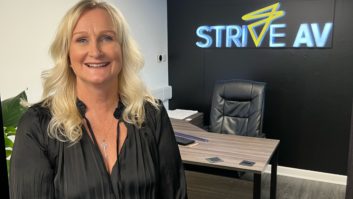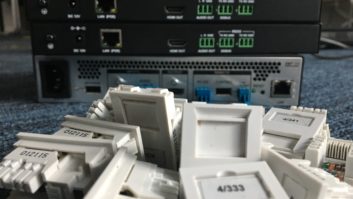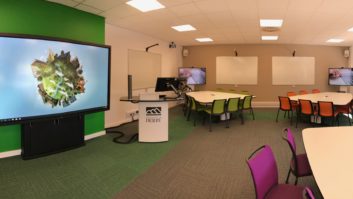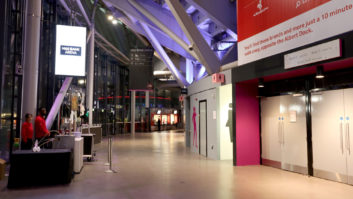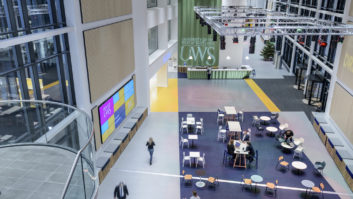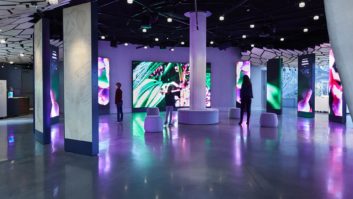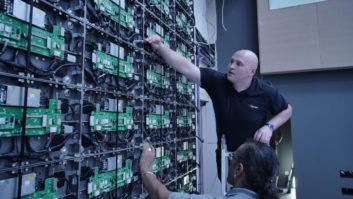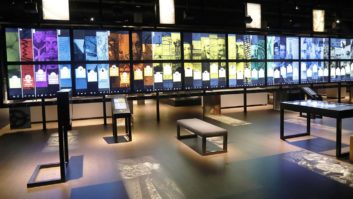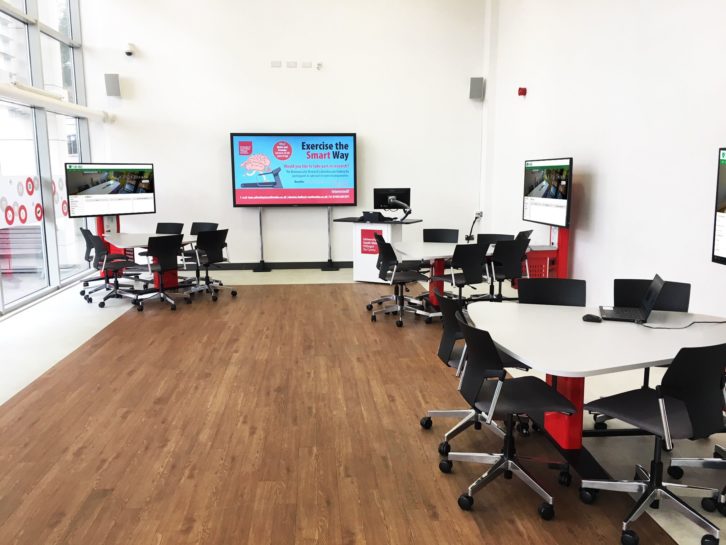
Toni Moss, managing director of UK-based CDEC, talks about navigating the changing education sector and the technologies that are currently making an impact.
Tell us about CDEC
CDEC has been integrating AV solutions since 2000. We are a focused and dynamic group of experienced AV professionals, who are highly driven by creating innovative solutions and delivering the very best AV for our customers.
Our team has seen the changes in AV, from the early days of introducing projection systems and interactive whiteboards to schools, to the current more complex configurations which are becoming more commonplace within the sector. To move with this change, our company has also evolved, and our team is more multi-skilled and experienced than ever before. Our project managers and solutions architects are busy ensuring all projects are delivered not just on time and in budget, but that they are technically accurately specified and scoped to ensure that our end users can facilitate excellent sessions, and can use technology to enhance the experience of collaborative working and learning.
CDEC’s vision is reflected in the way that our teams work together – our staff come from all over the UK, and from a range of backgrounds – both professionally and personally, but we share the company’s core values to inspire, to educate, for creativity and excellence and of respect and commitment. It’s also important to me that we promote a diverse workforce and reflect our wider communities; we are fully committed to being an equal opportunities employer.
What’s your geographic reach?
Our company started in the outskirts of London, in Kent, so naturally we have always had a strong presence in the South East. However, having grown organically over the years, we now have a national presence right across England and Wales.
We have a fairly even split of customers across all phases of the education sector, from nursery schools to large multi-site universities, as well as a growing base of customers from other verticals, including the health and corporate sectors.
What trends are you seeing in the education sector?
Current trends in education which we are seeing gain momentum have the common aim of enhancing student engagement and improving the student experience by facilitating group and collaborative learning.
The trends do vary across the different phases of education – at primary and secondary level we are seeing a move away from traditional projection systems and more LFDs IFPs, and certainly in the secondary phase we are getting more involved in designing bespoke spaces, such as hall systems with more professional audio, display and lighting integration, particularly to enhance performance spaces.
The continuing shift towards non-didactic teaching, particularly in the higher education environment, means technology is being used to facilitate this and to create opportunities for innovative teaching approaches.
There is an increase across the HE sector in creating engaging huddle spaces and we have seen manufacturers respond to this, including furniture specialists such as Top-Tec, and TK-Team, who are proactively taking this into account in their designs. This trend is beginning to be picked up by secondary phases, to provide alternative break-out spaces for their students.
Space is at a premium across the sector and so providing flexible, multi-use working and learning spaces is becoming a high priority, and we are designing solutions which can quickly be adapted and moved, and which provide maximum value for the spaces they are in.
Also in HE, the NSS (National Student Survey) directly interrogates the students on their view of their institution’s IT and AV facilities, and while there is no direct correlation between this and TEF data and indeed awards, there is inevitably some influence there, and so institutions are more aware than ever before of the need to provide conducive working spaces.
In addition, buildings/facilities management are more involved in design, and we are also seeing more interest in ‘Lone Rooftop’, and ‘Space- as-a-Service’ for example.
Are tech expectations changing across educational establishments?
Yes – in order to achieve effective collaborative spaces, there has to be the initiative from key manufacturers to meet the customer’s expectations.]
Driving technologies for this are the likes of Mersive, which has taken the collaboration tool to the next step, along with more traditional manufacturers like Top-Tec with its furniture design, and so education institutions should be finding this approach more and more commonplace.
AV has to combine the strategy of being packed away quickly and moved around in order to facilitate flexible learning spaces. BYOD has also gained momentum, and to this end, AirPlay and Miracast are the two protocols that have won the proprietary war.
There is also an expectation that technology can engage students and staff alike when it comes to digital signage. We are seeing more requests for solutions which will link into student management systems, and to make signage more data driven and interactive, rather than the static PowerPoint styles of old!
What projects are you particularly proud of?
Of course we are very proud of all of our projects, but some of our highlights include a full AV fit of 16 new build schools in Leicestershire – classrooms, halls and digital signage – which we completed in six weeks that were originally due to be done over six months; a dual projection solution at University of Brighton; the creation of a fully integrated ‘Explore Floor’ at Kensington Preparatory School; the successful delivery of AV in 91 spaces across Goldsmiths University in nine months, instead of a 30-month programme; digital signage, live TV, VC, lecture and meeting spaces at the University of Oxford Big Data Institute (BDI). and the design, supply and install of a new auditorium in the Royal Dockyard Church, a listed building in Chatham Dockyards for Kent University.
What technologies are particularly hot in the education sector right now?
AVoIP is huge at the minute. It leads to a simplification of technology and the need for fewer boxes making it a much smarter approach to technology.
The value of acoustic panels is also being recognised as they provide better intelligibility in environments by minimising echo and sound reverberation, as well as being an attractive addition to the space itself.
Focus Pods, which provide small focused spaces that are fully insulated from external noise, and can include writing surfaces or recessed screens, are also hot right now.
And what’s your particular favourite and why?
While it is hard to choose one, AVoIP is my current favourite, as it allows our customers to maximise their spaces and has the potential for creating and delivering excellent AV in a simplified flexible space. I believe by simplifying the hardware, this opens up the possibilities for collaboration and for true flexible working and learning.
Are you facing any particular challenges in the industry?
There are inevitably challenges in all environments, but one key challenge is working with existing infrastructure, and the limitations that this can present. In particular where historically an institution has deployed a wide range of systems, typically control systems, there are some conversations to be had with customers about streamlining or standardising their spaces so as to engage their end users more effectively.
Academic engagement is also a huge challenge, and we are very supportive at CDEC and provide additional consultative support and training to ensure that end users are confident and comfortable with the AV we integrate. Several members of our team have worked in the education sector – across all phases and, as a team, we enjoy sharing ideas and experiences we have had first hand both with each other and with our customers and end users.
Has the role of an integrator changed in recent years?
Yes – we believe that to be a true integrator you have to be able to be agile. It is not about shifting boxes and boxes of hardware; the role is now much more consultative and supportive than ever before and requires a high degree of understanding of our customers requirements and ambitions for their spaces, combined with outstanding technical and product knowledge and awareness.
Why should end users employ an integrator rather than attempt to go it alone?
With all the will in the world, while our end users will of course have excellent working knowledge of technologies, they do require input from specialists and from integrators who have more time to identify solutions from a range of sources, which they possibly would not have the same access to. Also, in terms of purchasing power, integrators will always be better placed to negotiate with manufacturers than single customers, and provide a full wrap-round service, which an end user may not be able to achieve within their institution alone.
What are some of the biggest mistakes made by end users when it comes to AV?
One common mistake is when end users responsible for delivering new AV projects rely on the same manufacturers who they know from the more traditional AV systems. That’s not to say they are not fit for the job, or are not innovative, but we have seen that quite often there is no needs analysis carried out to be able to then benchmark and test a range of products prior to purchasing.
